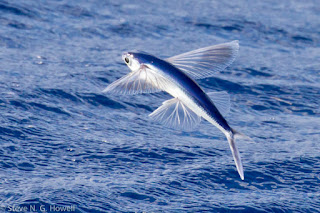Last week, in the hot calm conditions, several people opined that we needed some wind, even though we saw plenty of birds back then. Well, today we got some wind – 15 knots or so from the north, blowing against cross swells and the northward-flowing Gulf Stream made for a choppy, white-cap day. Viewing conditions were challenging, with birds getting lost in the troughs, but there was plenty to watch, and fewer birds meant we could study what we saw.
We enjoyed some great looks at Black-capped Petrels, including at least two dark-faced types, our first of the season and likely a different species from the white-faced type that predominates here in spring. (Later in summer, the black-faced types predominate, and they differ in their molt timing from the white-faced birds, indicating a different breeding season). We also had excellent comparisons of Great and Cory’s Shearwaters behind the boat for a long time. Moreover, we had a chance to compare the two ‘subspecies’ (= species) of Cory’s, when a Scopoli’s Shearwater (the Mediterranean-breeding taxon) joined 2 ‘regular’ (= Atlantic-breeding) Cory’s and 2 Greats for over 30 minutes.
Careful observation of the Great Shearwaters revealed a recently fledged juvenile, our first of the season; most other birds have been 2-year olds completing wing molt, plus a few 3rd-years, with very worn wings just starting molt. (The adult Greats bypass us here, heading to molt in waters off New England and Atlantic Canada.) Wilson’s Storm-Petrels were with us almost continually, and several molting Band-rumped Storm-Petrels showed well, being of the winter-breeding population (= cryptic species) known as Grant’s Storm-Petrel.
A nice selection of flyingfish and some bow-riding Bottlenose Dolphins rounded out another fine day at sea off Hatteras.
Thank you to everyone who joined us offshore today and to Jamie Cameron, Steve NG Howell, and Nick Bonomo for helping to lead the trip! Thanks to Steve for composing the blog post and contributing photos for today! -Kate
Black-capped Petrel 12
Cory's Shearwater 43
Great Shearwater 7-8
Audubon's Shearwater 5
Wilson's Storm-Petrel 81
Band-rumped Storm-Petrel 5
Barn Swallow 1
Bottlenose Dolphin 23-26
Black-capped Petrel, white-faced, well into wing molt
Black-capped Petrel, dark-faced not yet starting wing molt
Black-capped Petrel (center) between Great (left) and Cory’s Shearwaters
Cory’s Shearwater, the ‘regular’ type; note the dark ‘hand’ to the underwing
Scopoli’s Shearwater, smaller, slighter, and narrower-winged than Cory’s, with white fingers in the hand
Cory’s Shearwater getting air
Fresh-plumaged juvenile Great Shearwater
Wilson’s Storm-Petrel, compare shape with Band-rumped (next photo)
Band-rumped Storm-Petrel (Grant’s type), compare the structure with the Wilson’s preceding
Bottlenose Dolphins, offshore type
Atlantic Patchwing, usually the commonest big flyingfish we see













I wish I had gotten photos that nice of the Black-capped Petrel, but of course I can't maintain my footing as well on the boat as Steve can! Same goes for the Band-rumped Storm-Petrels. But I do have a nice photo of BOTH a Scopoli's and Atlantic Cory's Shearwater in the same frame, showing the undersides of the primaries. I will be updating my eBird checklist with photos over the next day or two. Thanks for a nice trip!
ReplyDelete